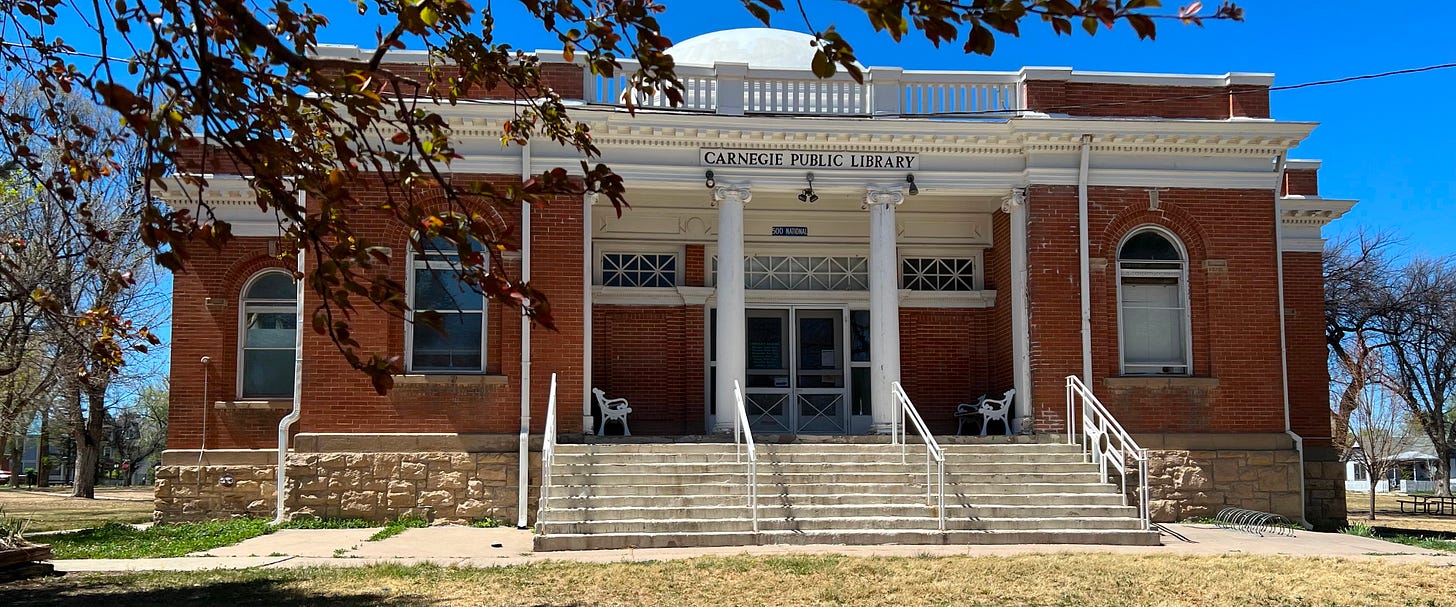
All you writers and readers and anyone who ever needed to look stuff up—it’s National Library Week. Let’s give thanks, not to Benjamin Franklin, who established America’s first library in 1731, and not to the generations of hard-working librarians since. Instead, let’s dedicate a page to the world’s (other) richest man—American industrialist Andrew Carnegie.
Andrew Carnegie, 1901. $300 Billion to 372 Billion (2025 dollars)
Elon Musk, 2025. $378 Billion
By the turn of the twentieth century Carnegie had made a fortune in railroads, steel and oil and was looking for ways to donate his money for the "improvement of mankind." He chose libraries. Between 1883 and 1929, Carnegie funded the building of 1,687 Carnegie Libraries in America, of which three were in New Mexico.
Carnegie’s decision to support libraries was born from his family’s experience. In 1846, at age 13, he immigrated to America with his family from Dunfermline, Scotland, where his father had been a weaver. At the factory, the elder Carnegie had convinced his fellow weavers to pool their money to buy books. One of them would be selected to read aloud while the others worked. These books became the first circulating library in town. In 1881, Dunfermline would be awarded the first Carnegie library.
New Mexico was a late beneficiary of Carnegie’s largesse. For one thing, the building grant stipulated that the selected town must have a population of 1,000 or more. Also, the building grant required that the town donate or purchase an appropriate site for the building and pledge at least $1,000 a year for maintenance. The building grants were to be used exclusively for construction, but the library’s design was left to the community. However, the library building could not be for multipurpose uses, such as public baths and bowling alleys. In the end, only three towns in New Mexico went on to build Carnegie libraries—Las Vegas in 1904, Roswell in 1906, and Raton in 1912.
Las Vegas’ prosperous history and desire for a public library put it in good position to receive the first grant. In 1885 a group of the town fathers had attempted to open a reading room in one of the plaza buildings, but their efforts were short-lived. Two years later, the Woman’s Christian Temperance Union opened their reading room with the idea that “young men will come in and be out of reach of temptation.” Whether or not it met its goal, the library didn’t last. Also, town officials offered a room on the first floor of city hall, but no funding for a librarian.
The city council applied for a Carnegie grant in March 1902. The next year Las Vegas received $10,000 from Carnegie to build its library. The city selected an architectural design modeled after Thomas Jefferson’s home, Monticello. It was set on block-long grassy park, Carnegie Park. The library, complete with domed rotunda, was finished in August 1904. Today, the library in Carnegie Park remains the only active Carnegie library in New Mexico.
“By eliminating the only federal agency dedicated to funding library services, the Trump administration’s executive order is cutting off at the knees the most beloved and trusted of American institutions and the staff and services they offer.” American Library Association’s March 15, 2025 response to President Trump’s order to shut down the Institute of Museum and Library Services.
From the nation’s founding, public libraries have represented the best of the American experience. This week, let’s give thanks to the steadfast librarians and library supporters who hold to the principles of a free library and unfettered access to knowledge.
Based on One Book at a Time: The History of the Library in New Mexico, Linda G. Harris, New Mexico Library Foundation, 1998.




